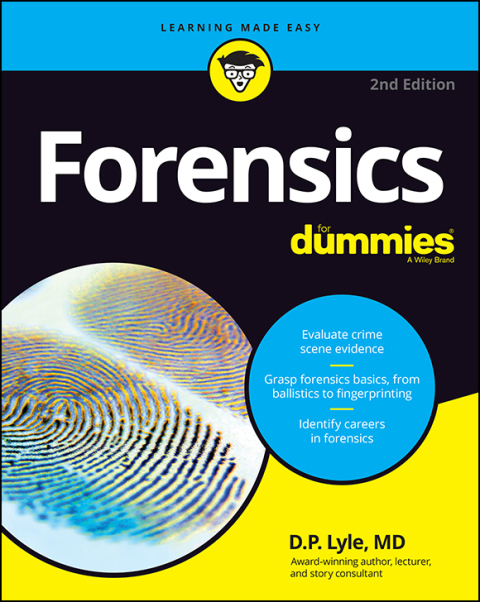Description
Efnisyfirlit
- Cover
- Introduction
- About This Book
- Foolish Assumptions
- Icons Used in This Book
- Beyond the Book
- Where to Go from Here
- Part 1: Cracking Open the Case
- Chapter 1: Understanding the World of Forensic Science
- Defining Forensics: The Science of Catching Criminals
- Getting the Big Picture: Forensic Science in Action
- Investigating the Crime Lab
- Peeking Inside the Criminalist’s Toolbox
- The Cornerstone of Forensic Science: Locard’s Exchange Principle
- Chapter 2: Getting to Know the Forensics Team
- Gathering the Evidence: The Criminalist at Work
- From Analyzing Blood to Identifying Bugs: Forensic Science Specialists
- Forensic Investigation’s Head Honcho: The Medical Examiner
- Dealing with the Dead: The Coroner’s Technician
- Testifying as an Expert
- Chapter 3: Collecting and Protecting the Evidence
- Assessing the Scene of the Crime
- Classifying the Evidence
- Locating the Evidence
- Collecting and Preserving the Evidence
- Locating a Missing Corpse
- Chapter 4: Delving into the Criminal Mind
- Defining the Role of the Forensic Psychiatric Professional
- Assessing the Brain
- Dealing with Deception
- Assessing Competence and Sanity
- Tracking Serial Offenders
- Profiling the Perpetrator
- Linking Criminals and Crime Scenes
- Part 2: Analyzing the Evidence
- Chapter 5: Fingerprints: Your Personal Signature
- Getting a Grip on Fingerprints
- Making Matching Easier: Classifying Prints
- Locating Those Sneaky Prints
- Chapter 6: Painting A Gruesome Picture: Bloodstain Analysis
- Understanding Blood’s Character
- Analyzing Bloodstain Patterns
- Putting It All Together: A Hypothetical Case
- Chapter 7: Leaving Impressive Impressions: Shoes, Tires, and Tools
- Stepping Out: Shoeprints as Evidence
- Tracking Down Tires
- Prying Clues from Tool Marks
- Finding Facts in Fabrics
- Chapter 8: Burning Down the House: Is It Arson?
- Striking the Match: Looking into Fire-Starters
- Determining Where and How the Fire Started
- Heating Things Up: Accelerants
- Investigating Homicidal Fires
- Evaluating Explosive Situations
- Part 3: Examining the Body
- Chapter 9: Determining the Cause and Manner of Death: Forensic Autopsies
- Defining Death and Declaring It as Such
- Shadowing the Forensic Pathologist
- Performing an Autopsy
- Filing the Official Autopsy Report
- Chapter 10: Identifying Unknown Victims
- Identifying the Body
- Using DNA To Make the ID
- Dem Bones, Dem Bones: Working with Skeletons
- Reconstructing Faces
- Comparing Photographs
- Chapter 11: Estimating the Time of Death
- Defining Time of Death
- Examining the Body to Estimate Time of Death
- Gathering Other Clues
- Chapter 12: Ouch! That Hurts: Traumatic Injuries and Deaths
- Unleashing the Power of Guns and Gun Evidence
- Slicing, Dicing, and Stabbing
- Taking the Hit: Blunt-Force Trauma
- A Shocking Situation: Electrocution
- The R Word: Dealing with Rape
- Chapter 13: Gasping for Air: Asphyxia
- Understanding Asphyxia
- Gasping for Oxygen: Suffocation
- Grasping Strangulation
- Inhaling Deadly Air: Toxic Gases
- Drowning: Water, Water Everywhere
- Part 4: Utilizing the Crime Lab
- Chapter 14: Analyzing Blood and Other Bodily Fluids: Serology
- Blood: Life’s Most Precious Fluid
- Identifying a Bloodstain’s Source
- Testing for Paternity
- Looking at Other Bodily Fluids
- Chapter 15: Looking Deep Inside: DNA Analysis
- Opening an Instruction Manual for Your Cells
- Fingering Criminals Using DNA Fingerprints
- Understanding the DNA Fingerprinting Process
- Using DNA to Determine Lineage
- Chapter 16: Testing for Drugs and Poisons: The Toxicology Lab
- Understanding Poisons
- Defining Toxicology
- Seeking Toxins
- Examining the Testing Procedures
- Looking at Common Drugs
- Checking Out Familiar Poisons
- Chapter 17: Picking Apart Trace Evidence
- Defining Trace Evidence
- Understanding Analytical Instruments
- Splitting Hairs: Linking Crime to Coiffure
- Fiddling with Fibers
- Cracking the Mysteries of Glass
- Puttering with Paints
- Getting Down and Dirty: Soils and Plants
- Chapter 18: Bang! Bang!: Analyzing Firearms Evidence
- Figuring Out Firearms
- Extracting Info from Ammo
- Getting Groovy: Comparing Rifling Patterns
- The Proof’s in the Powder: Gunshot Residues
- Chapter 19: Questioning the Validity of Documents
- Analyzing Handwriting
- Exposing Alterations
- Looking for Indentions
- Examining Papers and Inks
- Dissecting Typewriters and Photocopiers
- Part 5: The Part of Tens
- Chapter 20: Ten Famous Forensic Cases
- Using a Homemade Ladder: The Lindbergh Kidnapping
- Sacco and Vanzetti and Sacco’s Gun
- Ted Bundy’s Bite Marks
- Stella Nickell’s Trail of Fingerprints
- Finding Fibers on Jeffrey MacDonald
- Georgi Markov and the Lethal Umbrella
- The Hendricks Family’s Last Meal
- Picturing John List
- Being Anastasia Romanov
- Faking Hitler’s Diaries
- Chapter 21: Ten Ways Hollywood Gets It Wrong
- The Quick Death
- The Pretty Death
- The Bleeding Corpse
- The Exact Time of Death
- The One-Punch Knockout
- The Disappearing Black Eye
- The Fast-Acting Poison
- The Untraceable Poison
- The Instant Athlete
- The High-Tech Lab
- Chapter 22: Ten Great Forensic Careers
- Criminalist
- Crime Scene Investigator
- Forensic Investigator
- Forensic Pathologist
- Forensic Pathology Technician
- Forensic Anthropologist
- Forensic Toxicologist
- Fingerprint Examiner
- Forensic Document Examiner
- Forensic DNA Analyst
- Index
- About the Author
- Connect with Dummies
- End User License Agreement






Reviews
There are no reviews yet.